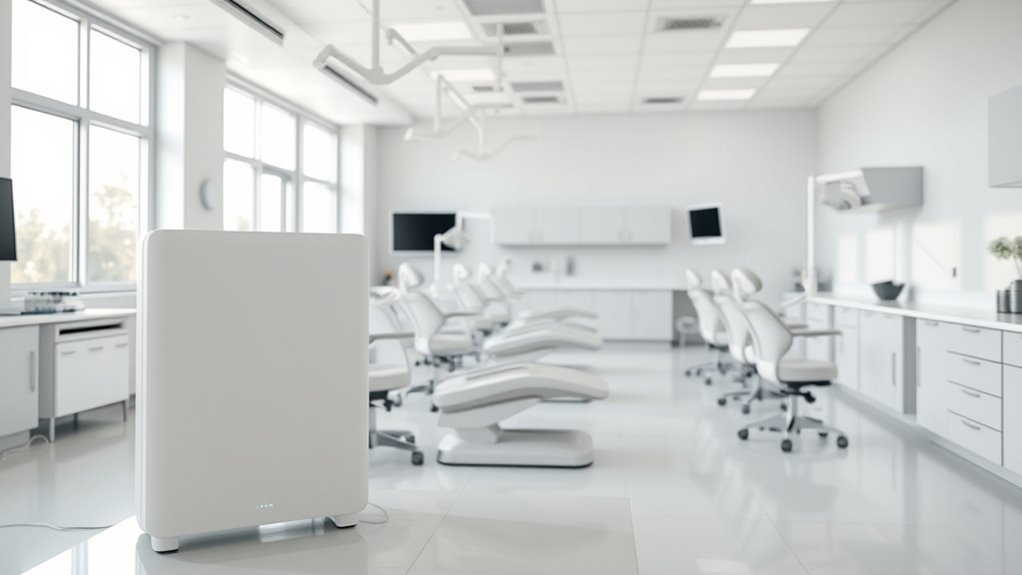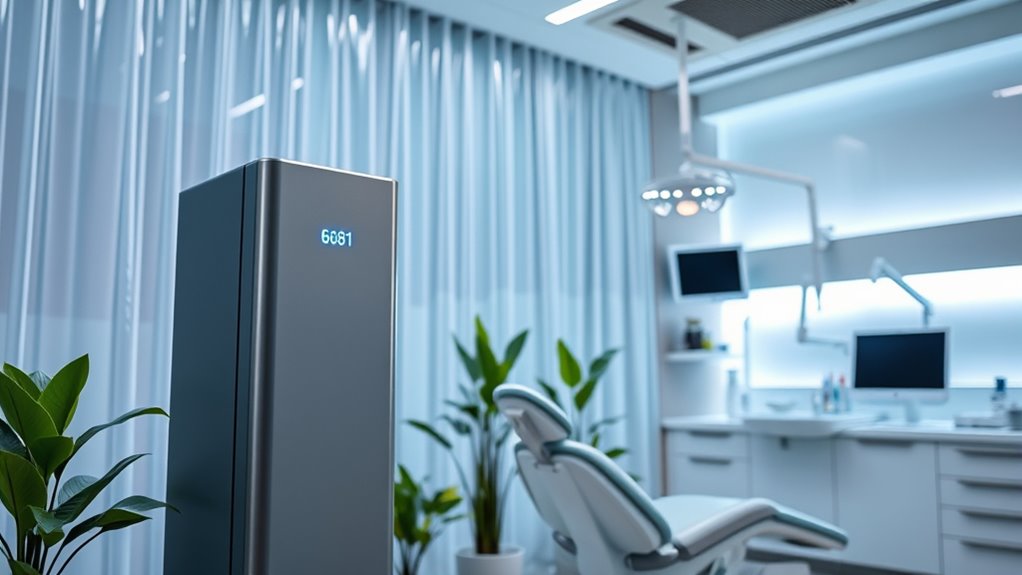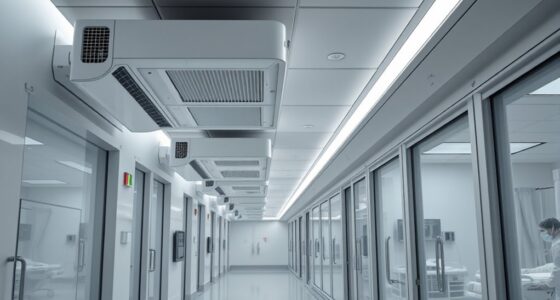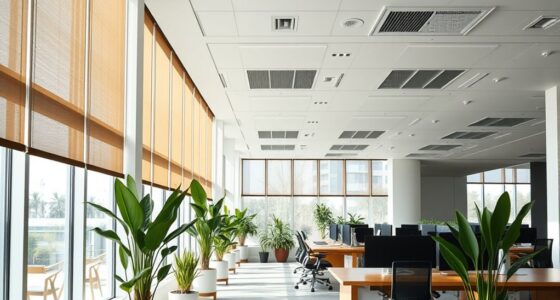To ensure a safe environment in your dental or medical clinic, prioritize effective air purification systems that remove airborne contaminants, bacteria, and viruses. Use high-quality HEPA filters combined with activated carbon to tackle particles, odors, and chemical vapors. Regular maintenance and proper ventilation strategies, like negative or positive pressure rooms, help contain or remove airborne hazards. Staying up-to-date with advanced filtration technologies can considerably reduce infection risks—continue exploring to learn how to optimize your clinic’s air quality further.
Key Takeaways
- Implement HEPA and activated carbon filters to effectively remove airborne particles, bacteria, viruses, and chemical odors in clinical settings.
- Regularly maintain and replace filters to ensure continuous high-quality air purification and prevent system degradation.
- Design ventilation strategies such as negative pressure rooms for infectious control and positive pressure rooms for immunocompromised patients.
- Use advanced filtration technologies and monitor air exchange rates to optimize indoor air quality and reduce infection risks.
- Incorporate comprehensive air management plans that combine filtration, ventilation, and airflow control for a safer clinical environment.

Have you ever wondered how dental and medical clinics keep the air safe for both staff and patients? The answer lies in their focus on maintaining excellent air quality through advanced filtration systems. These systems are essential for removing airborne contaminants, including bacteria, viruses, and particulate matter, which are common in healthcare environments. Good air quality isn’t just about comfort; it’s a critical factor in preventing the spread of infections and ensuring a healthy space for everyone.
Maintaining air quality with advanced filtration systems is vital for safe healthcare environments.
You should know that filtration systems in these clinics are designed to handle the unique challenges of medical environments. High-efficiency particulate air (HEPA) filters are a common choice because they can trap particles as small as 0.3 microns with 99.97% efficiency. This means that even microscopic bacteria and viruses are removed from the air, reducing the risk of cross-contamination. Many clinics also incorporate activated carbon filters, which help eliminate odors and chemical vapors that can compromise air quality. Combining these filtration systems creates a comprehensive barrier against airborne hazards.
Implementing proper air filtration isn’t just about installing equipment; it’s about ensuring the system works continuously and effectively. Regular maintenance, such as replacing filters on schedule, is vital to keep the air clean. If filters become clogged or degraded, airflow can decrease, and contaminants can bypass filtration, jeopardizing air quality. You should also consider the air exchange rate—how often the air in a room is refreshed. Higher rates mean fresher, cleaner air, which is especially crucial in procedures that generate aerosols, like dental cleanings or surgical interventions.
Another crucial aspect is airflow management. Proper ventilation design ensures contaminated air doesn’t linger in patient or staff areas. Many clinics use negative pressure rooms for infectious patients, which contain airborne pathogens and prevent their spread to other parts of the facility. Conversely, positive pressure rooms protect immunocompromised patients by keeping airborne contaminants out. These practices, combined with filtration systems, create a layered approach to maintaining safe air quality.
Additionally, considering the use of advanced filtration systems can significantly enhance the safety of healthcare environments by capturing smaller particles more efficiently. In your role, understanding the importance of air filtration systems can help you advocate for proper maintenance and upgrades. Regularly checking filters, ensuring optimal airflow, and staying informed about new filtration technologies all contribute to a safer environment. When you prioritize high-quality air filtration, you’re actively reducing infection risks and supporting the health of everyone inside the clinic. In essence, clean, well-filtered air is a cornerstone of effective healthcare environments, safeguarding both staff and patients every day.
Frequently Asked Questions
How Often Should Air Filters Be Replaced in Clinical Environments?
You should replace air filters every 6 to 12 months, depending on your clinic’s usage and air quality monitoring results. Regular filter maintenance guarantees ideal air quality and prevents contamination. Keep an eye on filter indicators or perform routine inspections to determine if replacements are needed sooner. Consistent filter changes maintain a safe environment for patients and staff, reducing airborne pathogens and improving overall air purification efficiency.
Are There Specific Air Purifiers Recommended for Dental Clinics?
You should choose air purifiers specifically designed for dental clinics that effectively handle dental aerosols and support medical sterilization standards. Look for units with HEPA filters and UV-C sterilization features to capture airborne particles and eliminate pathogens. These purifiers help maintain a safe environment by reducing airborne contaminants, ensuring compliance with health regulations, and protecting both staff and patients from infection risks associated with dental aerosols and other airborne hazards.
What Is the Cost Difference Between Various Air Purification Systems?
The cost comparison between different air purification systems varies widely, depending on features and capacity. Basic models tend to be more affordable, often costing a few hundred dollars, while advanced systems with HEPA filters and UV sterilization can reach thousands. You’ll want to contemplate system affordability alongside long-term benefits, like improved air quality and reduced infection risk, to choose the best option for your clinic’s needs and budget.
Do Air Purifiers Eliminate All Types of Airborne Pathogens?
Air purifiers can’t eliminate all airborne viruses, but they markedly reduce them. Their filtration efficiency varies, so high-quality systems with HEPA filters are best at capturing airborne viruses and other pathogens. You should choose an air purifier designed for maximum filtration efficiency, especially in sensitive environments like clinics. While they greatly improve air quality, combining purifiers with other safety measures offers the best protection against airborne viruses.
How Does Air Purification Impact Patient and Staff Safety?
You’ll find that air purification markedly enhances safety, reducing airborne contaminants by up to 99%. This improves air quality monitoring, allowing you to detect and address issues promptly. Staff training programs ensure your team understands proper filtration practices, maximizing protection for patients and staff. Overall, implementing air purification creates a safer environment, minimizes infection risks, and boosts confidence in your clinic’s commitment to health and safety.
Conclusion
Think of your clinic’s air purification system as a shield, silently standing guard against unseen threats. It clears the air like a gentle breeze, ensuring every breath your patients and staff take is pure and safe. By investing in the right technology, you create a fortress of cleanliness that fosters trust and health. Remember, a clean environment isn’t just a goal—it’s the foundation of your practice’s integrity, a lighthouse guiding everyone safely through the fog.









